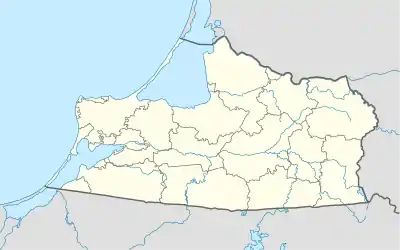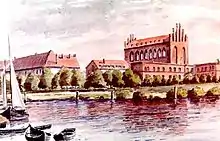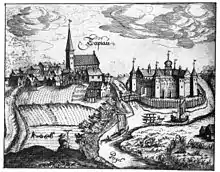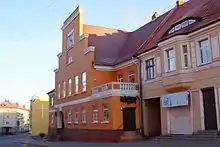Gvardeysk
Gvardeysk (Russian: Гвардейск, IPA: [ɡvɐrˈdʲejsk] (![]() listen)), known prior to 1946 by its German name
listen)), known prior to 1946 by its German name ![]() Tapiau (Lithuanian: Tepliava; Polish: Tapiawa/Tapiewo), is a town and the administrative center of Gvardeysky District in Kaliningrad Oblast, Russia, located on the right bank of the Pregolya River 38 kilometers (24 mi) east of Kaliningrad. Population figures: 13,899 (2010 Census);[3] 14,572 (2002 Census);[8] 11,904 (1989 Census).[9] It is located within the historic region of Sambia.[10]
Tapiau (Lithuanian: Tepliava; Polish: Tapiawa/Tapiewo), is a town and the administrative center of Gvardeysky District in Kaliningrad Oblast, Russia, located on the right bank of the Pregolya River 38 kilometers (24 mi) east of Kaliningrad. Population figures: 13,899 (2010 Census);[3] 14,572 (2002 Census);[8] 11,904 (1989 Census).[9] It is located within the historic region of Sambia.[10]
Gvardeysk
Гвардейск | |
|---|---|
Town[1] | |
 Central square in Gvardeysk | |
.png.webp) Coat of arms | |
Location of Gvardeysk 
| |
 Gvardeysk Location of Gvardeysk .svg.png.webp) Gvardeysk Gvardeysk (European Russia)  Gvardeysk Gvardeysk (Europe) | |
| Coordinates: 54°40′N 21°05′E | |
| Country | Russia |
| Federal subject | Kaliningrad Oblast[1] |
| Administrative district | Gvardeysky District[1] |
| Town of district significance | Gvardeysk[1] |
| First documented | 1254[2] |
| Town status since | 1722 |
| Elevation | 10 m (30 ft) |
| Population | |
| • Total | 13,899 |
| • Estimate (2018)[4] | 13,227 (−4.8%) |
| • Capital of | Gvardeysky District[1], town of district significance of Gvardeysk[1] |
| • Urban okrug | Gvardeysky Urban Okrug[5] |
| • Capital of | Gvardeysky Urban Okrug[5] |
| Time zone | UTC+2 (MSK–1 |
| Postal code(s)[7] | 238210 |
| OKTMO ID | 27706000001 |
| Website | www |
History

Peter of Dusburg wrote of a settlement known as Tapiow, first documented in 1254, and the neighboring fort Surgurbi built by 1265.[2] The Old Prussian names were derived from the words tape, teplu, toplu, tapi, meaning "warm", and sur garbis, meaning "around the mountain". During the 13th century Prussian Crusade, the area was conquered by the Teutonic Knights. To protect Samland from the Nadruvians and Scalvians, the crusaders built a wooden fort between the Deime and Pregel Rivers in 1283–1290. This was replaced by Tapiau Castle, a stone Ordensburg, in 1351.
The settlement gradually became known by the German crusaders as Tapiau. Vytautas, the later Grand Duke of Lithuania, was baptized in Tapiau in 1385. Upon the request of the anti-Teutonic Prussian Confederation in 1454 Polish King Casimir IV Jagiellon incorporated the region and town to the Kingdom of Poland[11] and the Thirteen Years' War broke out. After the defeat of the Teutonic Knights in the war, in 1466, the town became part of Poland as a fief held by the Teutonic Knights.[12] After the transfer of the Grand Master's seat from Malbork to Königsberg, Tapiau became the site of the Order's archives and library from 1469 to 1722.

Tapiau became a part of the Duchy of Prussia, a vassal state of Poland, in 1525. The Tapiau Castle was often used as a second residence of the Prussian dukes; Albert of Prussia died there in 1568. It became a part of the Kingdom of Prussia in 1701, receiving town privileges from King Frederick William I of Prussia in 1722. It became a part of the newly established Prussian Province of East Prussia in 1773 and was administered in Landkreis Wehlau (1818–1945). Tapiau became a part of the German Empire during the unification of Germany in 1871.
In August 1939, the Germans imprisoned the principal, teachers, other staff and 162 students of the Polish gymnasium in Kwidzyn in the town.[13] They were held in the former psychiatric hospital. In September 1939, during the German invasion of Poland, which started World War II, it was converted into a prisoner-of-war camp for Polish POWs, and Polish teachers and youth were deported elsewhere.[14] Later on, students under the age of 18 were released, older students were forcibly conscripted to the Wehrmacht, while teachers and staff were deported to Nazi concentration camps,[14] where most of them were murdered.[15] Also a Nazi prison for women was operated in the town.[16]
Unlike most other towns in northern East Prussia, Tapiau was largely undamaged during World War II. Following the war's end in 1945, it was annexed by the Soviet Union and renamed Gvardeysk ("guard town") in 1946.[17] The town's German population of more than 9,000 either fled or were killed during the war, and those remaining after the war were expelled and gradually replaced by Soviet residents.
Administrative and municipal status

Within the framework of administrative divisions, Gvardeysk serves as the administrative center of Gvardeysky District.[1] As an administrative division, it is, together with one rural locality (the settlement of Prigorodnoye), incorporated within Gvardeysky District as the town of district significance of Gvardeysk.[18]
Within the framework of municipal divisions, since June 11, 2014, the territories of the town of district significance of Gvardeysk and of four rural okrugs of Gvardeysky District are incorporated as Gvardeysky Urban Okrug.[5] Before that, the town of district significance was incorporated within Gvardeysky Municipal District as Gvardeyskoye Urban Settlement.[5]
Coat of arms
The coat of arms of Gvardeysk depicts a bare hand holding a sword amongst clouds, beneath a golden sun. When the town was known as Tapiau before 1946, the golden sun also included the Tetragrammaton (Jehova-Sonne).[19]
Sights
Sights of Gvardeysk include a church from 1502 and the ruined Tapiau Castle, reconstructed into an orphanage in 1879. It has been used as a prison since 1945.
People
Tapiau's most famous resident was the German Impressionist painter Lovis Corinth (1858–1925), who donated the painting Golgatha for the altar of the town's church in 1910; the painting disappeared near the end of World War II. The house where Corinth was born still stands in Gvardeysk. Other notable people associated with the town include Albert, Duke of Prussia (1490–1568), who died in Tapiau.
References
Notes
- Law #463
- Oesterley, p. 676
- Russian Federal State Statistics Service (2011). "Всероссийская перепись населения 2010 года. Том 1" [2010 All-Russian Population Census, vol. 1]. Всероссийская перепись населения 2010 года [2010 All-Russia Population Census] (in Russian). Federal State Statistics Service.
- "26. Численность постоянного населения Российской Федерации по муниципальным образованиям на 1 января 2018 года". Federal State Statistics Service. Retrieved January 23, 2019.
- Law #319
- "Об исчислении времени". Официальный интернет-портал правовой информации (in Russian). June 3, 2011. Retrieved January 19, 2019.
- Почта России. Информационно-вычислительный центр ОАСУ РПО. (Russian Post). Поиск объектов почтовой связи (Postal Objects Search) (in Russian)
- Russian Federal State Statistics Service (May 21, 2004). "Численность населения России, субъектов Российской Федерации в составе федеральных округов, районов, городских поселений, сельских населённых пунктов – районных центров и сельских населённых пунктов с населением 3 тысячи и более человек" [Population of Russia, Its Federal Districts, Federal Subjects, Districts, Urban Localities, Rural Localities—Administrative Centers, and Rural Localities with Population of Over 3,000] (XLS). Всероссийская перепись населения 2002 года [All-Russia Population Census of 2002] (in Russian).
- "Всесоюзная перепись населения 1989 г. Численность наличного населения союзных и автономных республик, автономных областей и округов, краёв, областей, районов, городских поселений и сёл-райцентров" [All Union Population Census of 1989: Present Population of Union and Autonomous Republics, Autonomous Oblasts and Okrugs, Krais, Oblasts, Districts, Urban Settlements, and Villages Serving as District Administrative Centers]. Всесоюзная перепись населения 1989 года [All-Union Population Census of 1989] (in Russian). Институт демографии Национального исследовательского университета: Высшая школа экономики [Institute of Demography at the National Research University: Higher School of Economics]. 1989 – via Demoscope Weekly.
- Słownik geograficzny Królestwa Polskiego i innych krajów słowiańskich, Tom XII, Warszawa, 1892, p. 156 (in Polish)
- Karol Górski, Związek Pruski i poddanie się Prus Polsce: zbiór tekstów źródłowych, Instytut Zachodni, Poznań, 1949, p. XXXVII, 54 (in Polish)
- Górski, p. 96-97, 214-215
- Mirosław Cygański, Hitlerowskie prześladowania przywódców i aktywu Związków Polaków w Niemczech w latach 1939 - 1945, "Przegląd Zachodni", nr 4, 1984, p. 41 (in Polish)
- Justyna Liguz. "Rzeczypospolita Kwidzyńska - dzieje Polskiego Gimnazjum w Prusach Wschodnich". Interia Nowa Historia (in Polish). Retrieved October 3, 2020.
- Cygański, p. 43
- "Frauenzuchthaus Tapiau". Bundesarchiv.de (in German). Retrieved October 3, 2020.
- Энциклопедия Города России. Moscow: Большая Российская Энциклопедия. 2003. p. 105. ISBN 5-7107-7399-9.
- Resolution #640
- Hupp, p. 36
Sources
- Калининградская областная Дума. Закон №463 от 27 мая 2010 г. «Об административно-территориальном устройстве Калининградской области», в ред. Закона №450 от 3 июля 2015 г. «О внесении изменений в Закон Калининградской области "Об административно-территориальном устройстве Калининградской области"». Вступил в силу со дня официального опубликования. Опубликован: "Калининградская правда" (вкладыш "Ведомости Правительства Калининградской области"), №112, 26 июня 2010 г. (Kaliningrad Oblast Duma. Law #463 of May 27, 2010 On the Administrative-Territorial Structure of Kaliningrad Oblast, as amended by the Law #450 of July 3, 2015 On Amending the Law of Kaliningrad Oblast "On the Administrative-Territorial Structure of Kaliningrad Oblast". Effective as of the day of the official publication.).
- Правительство Калининградской области. Постановление №640 от 30 августа 2011 г. «Об утверждении реестра объектов административно-территориального деления Калининградской области», в ред. Постановления №877 от 21 ноября 2011 г «О внесении изменения в Постановление Правительства Калининградской области от 30 августа 2011 г. №640». Вступил в силу со дня официального опубликования. Опубликован: "Калининградская правда" (вкладыш "Официально"), №170, 15 сентября 2011 г. (Government of Kaliningrad Oblast. Resolution #640 of August 30, 2011 On the Adoption of the Registry of the Objects of the Administrative-Territorial Divisions of Kaliningrad Oblast, as amended by the Resolution #877 of November 21, 2011 On Amending the Resolution of the Government of Kaliningrad Oblast #640 of August 30, 2011. Effective as of the day of the official publication.).
- Калининградская областная Дума. Закон №319 от 10 июня 2014 г. «Об объединении поселений, входящих в состав муниципального образования "Гвардейский район", и организации местного самоуправления на объединённой территории». Вступил в силу со дня официального опубликования. Опубликован: "Калининградская правда" (вкладыш "Официальный вестник Правительства Калининградской области"), №103, 11 июня 2014 г. (Kaliningrad Oblast Duma. Law #319 of June 10, 2014 On the Merger of the Settlements Within the Municipal Formation of "Gvardeysky District" and on the Organization of the Local Self-Government on the Merged Territories. Effective as of the day of the official publication.).
- Hupp, Otto (1896/1898). Königreich Preußen: Wappen der Städte. Flecken und Dörfer (in German). Frankfurt: Verlag von Heinrich Keller. p. 185. Check date values in:
|year=(help) - Oesterley, Hermann (1883). Historisch-geographisches Wörterbuch des deutschen Mittelalters (in German). Gotha: Justus Perthus. p. 805.
